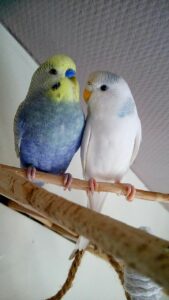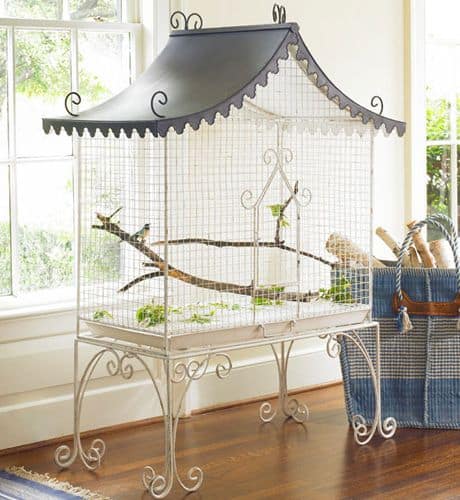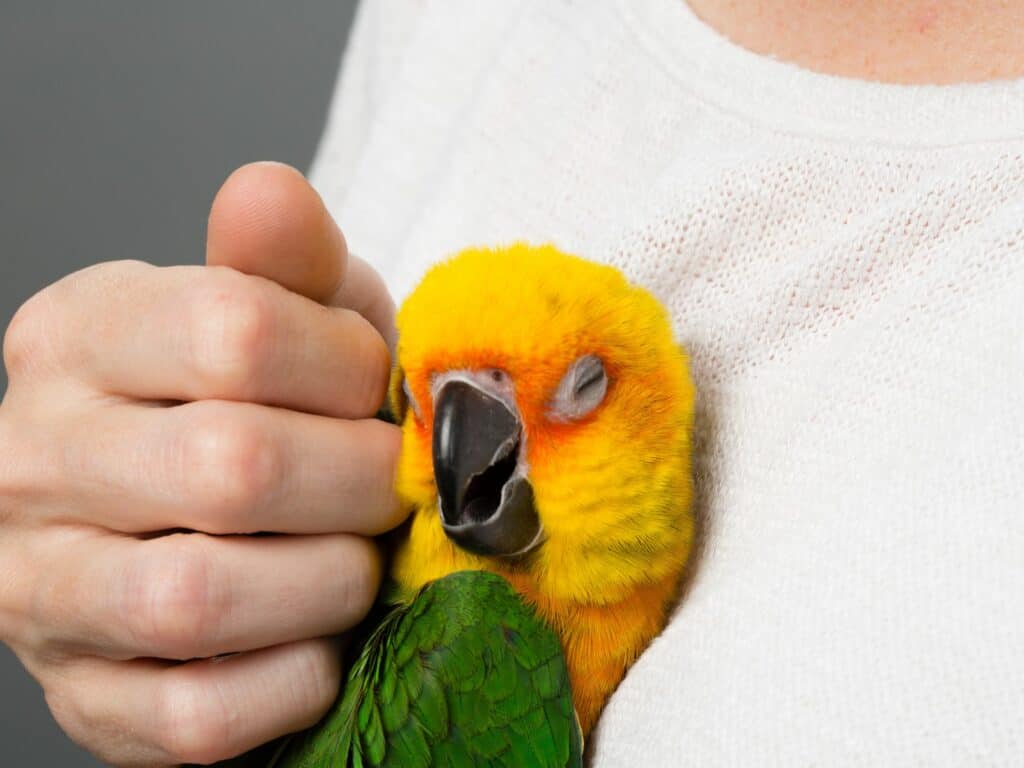Welcome to the world of parakeet care!
If you’re a proud owner of a colorful and chirpy parakeet or considering bringing one into your home, this article is just for you.
I’ll guide you through the essential tips and tricks to ensure your feathered friend leads a happy and healthy life.
From setting up the perfect cage to providing a balanced diet and fostering a strong bond, taking care of a parakeet can be a delightful journey for both of you.
Let’s dive in and make sure your parakeet’s wings are always soaring with joy!
Things to Know about Parakeets
There are a few things that any owner should know before owning a parakeet so that he can take better care of some things.
- Any parakeet or budgie has an average lifespan of 10 years
- These birds can also learn a lot of words from their owners and speak with them.
- These birds are lovely and friendly and can make out the best companion that you can have.
- They are quick learners, and they can learn a lot from their owners, such as basic commands like a step up and step back, etc.
How to Take Care of a Parakeet?
1. Give Good Quality and Healthy Food

A standard question that must be considered first because your budgie is highly likely to be affected by the quality of food it is being fed with.
Some food may make it sick, while there is some food like pellets, seeds, vegetables, fruits, nuts, and treats that are the best diet for your pet.
Parakeets have extremely dynamic digestion and can undoubtedly turn out to be sick in case they don’t feed within 24 hours.
Parakeets ought to be given a staple eating regimen of new parakeet seeds or pellets each day.
The owner needs to make certain to check the food dish day by day, as they will just eat from the highest point of what is advertised.
Feed your parakeet with fresh and clean food, and make sure to eliminate old food sources after two hours.
You can use clean water, seeds, and fresh fruits like Banana or Apple to keep your parakeet interested in the food and let your bird choose what he eats.
-
Water
You need to keep fresh water for your parakeet every day and don’t try to mix its food with the water.
Clean the water bowl every day and pour it with fresh water so that your budgie doesn’t get sick from any infection or bacteria present in the old water.
-
Seeds
You can use seeds and grains to feed your parakeet because this is mostly liked by all the parakeets in the world.
Seeds like safflower and groat to white sunflower and other seeds like canary seed are a good source of diet for your parakeet to take care of its health.
-
Fruits and Vegetables
Fruits are a basic necessity, and they are very healthy for your bird, and you must feed fresh fruits every day to your parakeet.
Parakeets love delicious food items like fruits and vegetables.
Try giving your parakeet fruits 2 or 3 times a week and do the same for veggies. Switch food each day, so your parakeet can enjoy different tastes and doesn’t get bored of the food.
You can make a list at your home and keep the following food items in your list to be more precise about what is the best food for your parakeet.
- Fresh vegetables
- Fresh fruits
- Seeds and Treats
- Water
2. Keep Your Parakeet Comfortable with the Environment
To ensure your parakeet stays glad and quiet, try to abstain from dealing with your new bird for three or four days.
He needs to become accustomed to his new environment.
This will you’re your bird get used to the environment around it, and he will become more familiar with you and the house.
This will reduce the chance of your bird getting scared or getting panic because of the new world that he has to face.
Let him be comfortable with the environment of your home for some days, and then you can get more involved with your pet.
3. Keep Them Paired Up with the Opposite Gender
Taking care of your parakeet requires a lot of consideration.
You even have to see whether it’s a male or female.
Both of them have different reactions and behavior to different situations.
Male parakeets don’t have much of a problem, but females do chatter a lot with each other, and they are hard to train too, which makes it harder to take care of them.

So in the event that you have a male bird, you may get him an equivalent sexual companion as a female parakeet.
In case you need a male parakeet and a female one, you’ll need a huge cage that offers the male space to get away from the female if she rejects his passion.
4. Make Parakeet’s Cage a Home

The types of cages needed for budgies or parakeets are normal in size.
For one or two parakeets, the cage should be a minimum of 18 inches wide by 14 inches deep and 22 inches high since they love to climb.
You can use a bigger cage for more than two parakeets.
Avoid toys with mirrors, at least initially.
Parakeets will interact with the bird in the mirror instead of you, or sometimes they might get offended by the reflection, thinking that this might be another bird.
So consider the following things when you keep parakeets in a cage.
- If you need to keep your birdcage in as perfect health as possible, you can consider getting a birdcage skirt. This will, in any event, keep part of the sheet material and waste inside the cage, with you having the option to slide the plate out and clean it effortlessly.
- Parakeets need separate dishes for water and food and a dish on the confined floor for washing.
- A hut or house of coconut ladder that keeps your parakeet warm and safe. It becomes a place to rest and hide for your bird. The ladder steps will make it jolly for your bird to spend its time learning new tricks.
- No matter the sort of number of embellishments and decorations you add in the cage, ensure that they are produced using materials that are only showcased as being alright for your birds and don’t do any harm to them.
5. Choose Proper Cage Size
For budgies, the size of the cage is very important.
Preferably cages ought to be around 14″ long, 16″ high, and 17″ wide for budgies and they must be having perches with are a fundamental expansion to any birdcage.
Make sure to utilize roosts that are the right size for your parakeet’s feet.
If the perch that you are using is too big, then your bird won’t be able to get a grip on it and get harmed very easily.
Try to use a suitable smaller perch to fit your parakeet’s feet.
Giving the number of shapes and surfaces of roosts will help practice a parakeet’s feet.
The situation of roosts is additionally significant.
Medical Needs for Parakeet Care
Your bird needs proper care and treatment, and you should be aware of all of its medical needs.
Taking care of your bird will require a lot of hard work and time effort to put in to groom your bird and improve its health.
You can take care of some things to avoid any medical unfitness to your bird.
1. Check Body Temperature
The average temperature range of a parakeet or budgie lies between 70 and 80 degrees Fahrenheit.
You have to be more careful and careful when you notice that your budgie is a bit off and its body is too warm, or if you see that your bird is getting lazy, the possibility is he is suffering from fever.
You should take precautions at the moment to protect your bird; otherwise, your budgie may lose its life.
Get to a vet doctor and get your help to protect your parakeet.
2. Trim Wings and Nails
The feathers of your parakeet should be trimmed every once in a while so that they remain in proper shape and have an excellent look.
The nails of your bird should be trimmed so that you don’t have any problem facing when you are trying to teach your bird the Step on and Step off trick.
You need to take care of its blood feathers because parakeets have a limited quantity of blood in their body which is also linked with blood feathers.
Don’t harm blood feathers while trimming its wings otherwise; you can lose your pet by causing its death.
3. Hunger and Appetite
Sound parakeets have a little craving for food, particularly around the start of the day.
If the bird loses its craving, it might be a sign that something isn’t right with your bird’s health.
Furthermore, budgies are dynamic and gymnastic, and they don’t remain calm for much time, so you will notice that your budgie is active or not feeling fell.
Treat your budgie with proper fresh food so that it remains healthy and active throughout the day.
Try not to ignore your pet if you notice that he is feeling down or not very active during the day.
4. Protect your Parakeet from these Common Diseases
You should know about the diseases that budgies do often suffer, and it is important for every owner to know about these diseases so that they can be cautious about their bird’s health.
Some signs of the following diseases will help you with knowing the most common type of diseases that occur in parakeets so that you will be able to understand the problem and act as soon as possible.
The most common diseases and their symptoms are shared below
-
Chlamydiosis
Chlamydiosis is a very bad and infectious disease mostly found in budgies that causes a bird to lose its appetite and nasal discharge along with green droppings.
This type of disease is also spread or passed on to other birds as well.
-
Feather Plucking
If your parakeet starts to pluck its own feathers, you should be aware that either its diet affects or lacking, or he is doing it out of boredom.
You shouldn’t let your pet do that and try to act as soon as possible for whatever from both is the reason for your bird doing this act.
-
Diarrhea
When you feed any food item which is not good for your parakeet, it mostly upsets the stomach of your bird and turns into Diarrhea.
Food poisoning is also one of the reasons for causing Diarrhea, and you have to get your bird treated as soon as possible so that it doesn’t get weak.
-
Mites
The mite is a common disease that is familiar to those parakeets who are kept in unsanitary conditions in any pet shop.
This disease causes a white deposit on the legs, feet, and eyes, and on the beak of the parakeet.
Try to keep your parakeet in a clean environment and feed him with clean food.
Foods to Avoid for Parakeets
In taking care of your parakeet’s health, you should be very conscious of what to choose and what not to.
Read properly about the food item first that you are about to give to your budgie; this will help you know what effect will it leave on your budgie’s health.
People often give bread pieces to their budgies which is not good for their health.
Sandwich bread has various additives and added substances that are not healthy for birds, so it is inadmissible for parakeets too.
Remember that birds are very immune to temperature if not fed well.
There should be proper care for your bird’s diet and avoid toxic or poisonous food which is not good for your bird.
Here is a list of items of food that are not good for your parakeet, and you should always avoid feeding your pet with these.
- Tomato leaves and stems
- Avocados
- Uncooked beans
- Raw peanuts
- Yucca
- Mushrooms
- Chocolate
Parakeets Like Being Petted
This isn’t something that is in the blood of a bird.
This is something in the character of the bird and how they were raised.
Some might be raised and not prepared the correct way, so they would have a dread of hands and would nibble as a protection system.
Others might be raised and prepared right and could possibly consistently have gotten a chance to get petted.

You should always remember to pet your parakeet as it creates a feeling of love and connection between the owner and the parakeet.
It causes a sense of relation and emotion, and the parakeet gets more comfortable and happy with its owner.
This basically implies acquiring its trust and holding on to it.
Pet Birds Need Care at Home
Birds that have been raised by people basically don’t have the foggiest idea of how to be wild birds.
They are not familiar with managing and adapting to the outer world environment.
They have to know idea how they will look for their own food.
They never figured out how to keep an eye out for hunters, and if they have been raised with other animals at home, they may take wild animals as friends and might end up getting themselves hurt or killed.
As a result of this, in the event that you set one of these birds free, you would almost certainly be sending them to their own death.
Human Bond with Parakeet
You need to know that pet bird species are pretty much savvy and intelligent, and they form a great bond of love with their owners.
Sending them out to fight for themselves causes them detachment, sadness, and nervousness.
This would break your bird’s heart and cause him to get sick or even die of sadness.
So you have to take care of your parakeet as long as you can keep it with you and try not to give it away or simply free it into the wild.
Conclusion
In conclusion, taking care of a parakeet requires dedication, patience, and a genuine love for these vibrant little creatures.
By providing a comfortable and stimulating environment, a nutritious diet, regular health check-ups, and plenty of attention, you can ensure your parakeet thrives and flourishes in your care.
Remember, every parakeet is unique, and understanding your feathered friend’s personality and needs is crucial to building a strong and trusting bond.
As you embark on this journey of parakeet care, you’ll discover the joy of witnessing their playful antics and hearing their cheerful songs.
Be prepared to invest time and effort, and your parakeet will reward you with years of companionship and affection.
By following the guidelines outlined in this article, you’re well on your way to becoming a responsible and loving parakeet owner.
So spread your wings together and enjoy the wonderful experience of nurturing a happy and content parakeet!
FAQ
What type of cage is best for my parakeet?
Choose a spacious cage that allows your parakeet to move freely and stretch its wings. A minimum cage size of 18x18x18 inches is recommended for a single parakeet. Opt for horizontal bars to facilitate climbing and ensure bar spacing is narrow enough to prevent escape. Provide perches, toys, and a secure door latch for added safety.
What should I feed my parakeet?
A well-balanced diet is crucial for your parakeet’s health. Offer a high-quality commercial parakeet seed mix as a base diet. Additionally, provide fresh fruits, vegetables, and leafy greens for added nutrition. Treats like millet sprays can be offered in moderation. Always ensure fresh, clean water is available.
How can I tame my new parakeet and build a bond with it?
Patience and gentle interactions are key to taming your parakeet. Spend time talking softly to your bird, offer treats from your hand, and allow it to explore outside the cage under close supervision. Avoid sudden movements or loud noises, as these can frighten the bird. Building trust takes time, so be consistent and kind.
How often should I clean my parakeet's cage?
Regular cleaning is essential to maintain a healthy environment. Clean the cage and perches at least once a week, removing droppings and soiled bedding. Change the water daily and replace the food as needed. A clean cage prevents the buildup of harmful bacteria and keeps your parakeet comfortable.
How much sleep do parakeets need?
Parakeets need about 10 to 12 hours of sleep every night. Ensure they have a quiet and dimly lit area to rest during the night. Covering their cage partially can help create a sense of security and promote better sleep.
Last Updated on August 2, 2023 by Lily Aldrin
